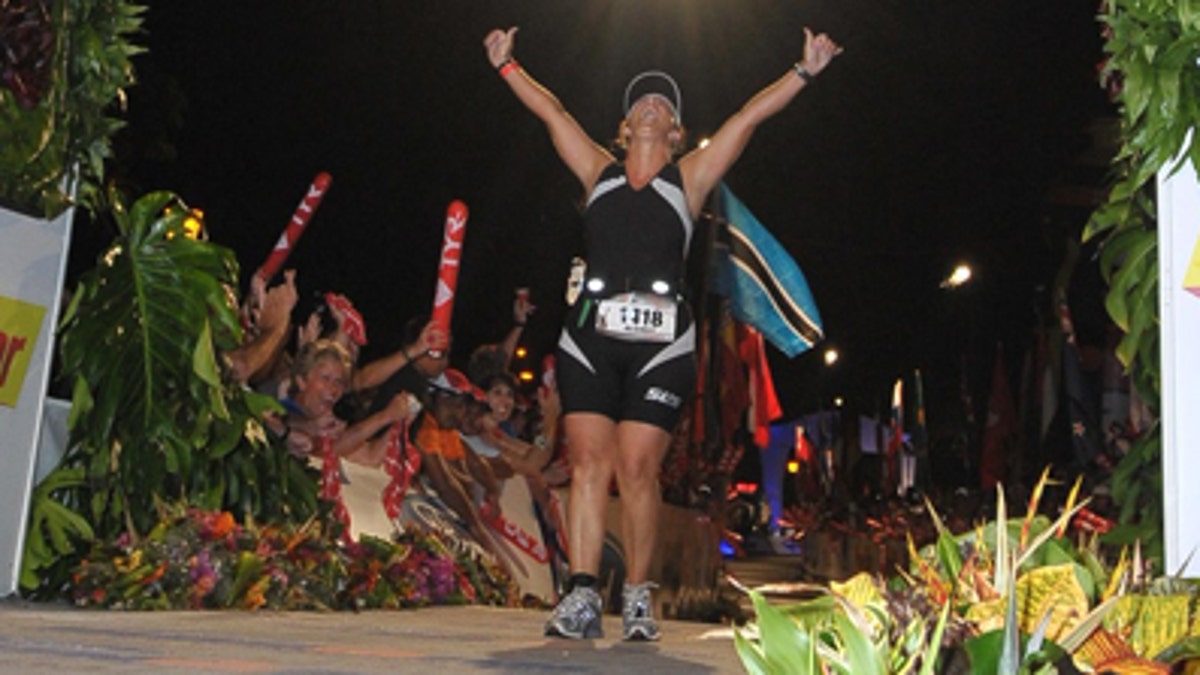
Desiree Hart-Wilson, of Washington, completes the Kona Ironman.
For many years, there has been a sports medicine conference coordinated with the Ironman World Championship in Kona, Hawaii. This year, I was lucky to be an invited faculty member, providing talks on sports nutrition and hydration.
The first day of the conference, I found out there was a “lottery” for one lucky medical conference participant (who put their name in the draw) to get a “golden ticket” to participate in the Kona Ironman the following year. The Ironman in Kona is the World Championship, known for its challenging course and limited number of participants (1,800 athletes). Just like the Boston Marathon, athletes must qualify. However, there were 200 lottery winners – who must complete at least one half Ironman prior to Kona.
Meet Desiree Hart-Wilson
I met Desiree Hart-Wilson, RN, and was intrigued to hear her story. She is not very tall, nor as petite as many of the athletes I met… yet she has a great, big smile, sparkling eyes and a lot of determination. This pediatric emergency room nurse had a funny feeling when she put her name in the drawing at last year’s conference that she would win. After the excitement of hearing her name read aloud wore off – she panicked, “What have I gotten myself into?”
To make matters worse, she worked in the medical tent during the Ironman and saw many of the athletes requiring assistance, and one athlete said to her, “Good luck” with plenty of sarcasm.
A Family Affair
This dynamo, Harley Davidson driving, mother of three, and scuba dive master had just started participating in some triathlons. Desiree’s husband, David Wilson, having completed several triathlons and a half Ironman, became her training partner. They live in Spanaway, Wash. Her dog was recruited for the runs, and her children helped with the bike rides. Her youngest child made her buy berry flats on the way home from their ride, as a reward for doing the ride with mom. Gee, what mother wouldn’t agree to those terms as a form of “payment” for a training partner?
Metamorphosis
Hart-Wilson was no stranger to the gym; she worked out for an hour or so, four to five days each week. Her training definitely changed the amount of time she spent swimming, cycling and running. The “short” days were two hours in duration, while the “long” days were six to eight hours a day. Did you read that correctly? Almost as many hours as most people work at their jobs or sleep! She became more aware of eating for fuel versus pleasure. Alcohol consumption tapered off significantly. As a night shift worker, she heard the excuse “I don’t have time” to exercise. Hart-Wilson said she felt, “worse on days that she rested and didn’t go to the gym” than when she sacrificed two hours of sleep to train. Dedication!
Body Changes
Hart-Wilson's weight remained somewhat stable, as her appetite increased, so did her caloric intake. However, she did notice that while the scale didn’t change, her body composition did. She lost body fat and increased muscle mass; reported that her resting and exercise heart rate decreased, as did her blood pressure.
Race Day
When asked if she had any fears about a particular part of the race, she said the bike was her most critical concern. A former competitive swimmer, the 2.4 mile swim in the Pacific Ocean was not a concern for her (although I watched the athletes practice every morning and I give them a lot of credit). The 112 miles of the cycling portion of the race can be grueling due to sun, wind and loneliness. The roads are closed in much of the area – so spectators – who are so important for moral support, are less dense in much of the bike route than in downtown Kona. The race ends with a full marathon (26.2 miles).
“I’m a completer, not a competer."
The experience was outstanding for Hart-Wilson. She spotted a pod of dolphins swimming near them in the ocean, simply magical. The bike ride was tough as she anticipated, but the views around Kona were breathtaking. Dehydration caused her to be completely nauseated at the beginning of the marathon run and she walked for the first hour trying to rehydrate and get her stomach to calm down.
Even though she finished late at night, on dark roads that were eerie, “hitting that last mile and seeing my family on Palani was great. The finish line energy is indescribable, going through that gauntlet of people toward the finish made me feel like a celebrity. Everyone had their hand out for high fives, and the cheers for everyone who crosses the line was just amazing.”
Perhaps you can see Hart-Wilson (#1418) and during the broadcast of the 2011 Kona Ironman this Saturday. As you can see from her photo, she finished about 52 minutes later than she predicted. Way to go!
Felicia D. Stoler, DCN, MS, RD, FACSM is a doctorally trained registered dietitian, exercise physiologist, TV personality and expert consultant in disease prevention, wellness and healthy living. She is the author of "Living Skinny in Fat Genes: The Healthy Way to Lose Weight and Feel Great." She hosted TLC's groundbreaking series "Honey We're Killing the Kids!" Become a fan of Felicia on Facebook, follow her on Twitter or visit her website FeliciaStoler.com
